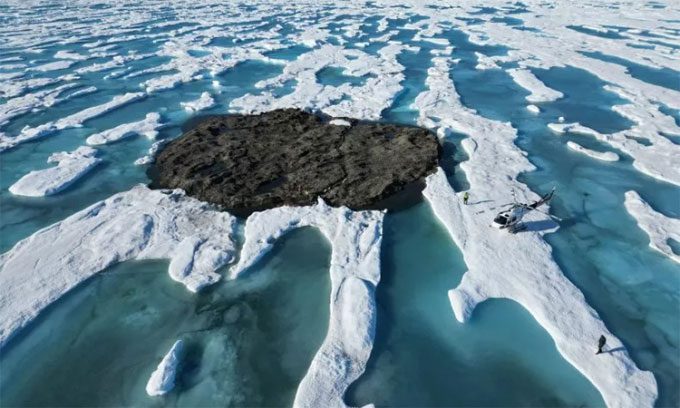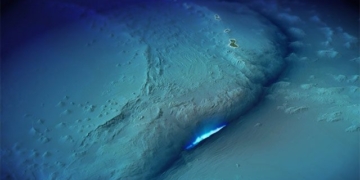The island Qeqertaq Avannarleq in northern Greenland is not an actual island but a flat-topped iceberg covered with an unusual layer of soil and gravel.
“Ghost Island” in the Arctic, once believed to be the northernmost landmass in the world, is actually a “dirty iceberg”, Newsweek reported on September 9. The island, measuring approximately 60 meters by 30 meters, was discovered offshore from northern Greenland by an expedition team of researchers from institutes in Switzerland, Denmark, and Greenland in 2021. They named the site “Qeqertaq Avannarleq”, which means “the northernmost island” in Greenlandic.

“Ghost Island” Qeqertaq Avannarleq in northern Greenland is actually a “dirty iceberg.” (Photo: Martin Nissen).
“This small, rocky island is considered a ‘contender’ for the title of the northernmost land ever recorded. However, this area has a strange mystery. Just north of Morris Jesup Cape, several other small islands have also been discovered over the decades, only to disappear later,” said Kevin Hamilton, a professor of atmospheric sciences at the University of Hawaii.
Morris Jesup Cape is located at the northernmost point of Greenland—the largest island in the world—about 710 kilometers from the Arctic. The first small island to disappear was discovered in the polar ice cap near Morris Jesup, named “Oodaaq Ø,” which was identified in 1978.
Since then, various expeditions have discovered similar “ghost islands.” Some researchers hypothesize that they are rocky outcrops on the seabed pushed to the surface by sea ice. They typically measure about 20 to 30 meters in thickness and have a thin surface layer of soil, gravel, and mud, according to Rene Forsberg, a researcher from the Technical University of Denmark.
Forsberg participated in an expedition to study this phenomenon this year. They visited several small islands in the area, including Qeqertaq Avannarleq, collecting GPS data and using laser scanning techniques to measure ice thickness and sea depth. Previously, the depth of this sea area had never been measured due to a semi-static sea ice layer 2 to 3 meters thick. The research revealed that these strange small islands are not actually islands but large icebergs trapped on the seabed.
Forsberg stated that new measurements clearly confirm that they are flat-topped icebergs with an unusual layer of soil and gravel on top, which have run aground. “They could be classified as semi-static ice islands with a lifespan of a few years,” he said.
This group includes Qeqertaq Avannarleq. Thus, the Inuit Qeqertaat, a true island, is the northernmost landmass in the world. The expedition team added that these ghost islands likely originate from a glacier located about 40 to 50 kilometers west of Morris Jesup.


















































